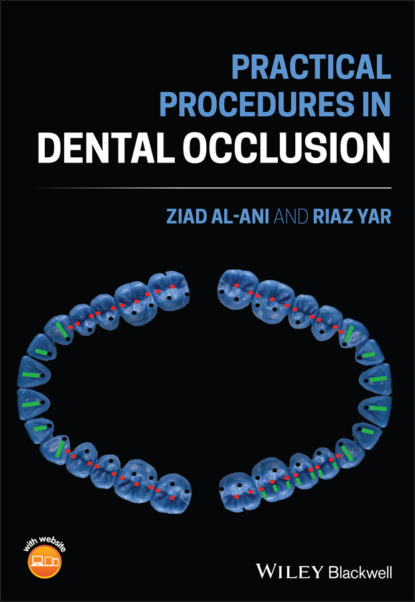href="#ulink_ca7b53a5-1953-58a0-9662-28be2a2ba1e5">Group Function Occlusion Mastication References Further Reading
20 13 Replacing Missing Teeth – Abutment is Involved with Guidance
21 14 The Space is Lost! Loss of Occlusal SpaceFollowing Crown Prep Dealing with This Problem Clinically Further Reading
22 15 My Front Teeth are Worn Scenario Rationale Procedure References Further Reading
23 16 All My Teeth Are Restored But Don't Meet Like They Did Before Scenario Rationale Procedure References Further Reading
24 17 I Am Breaking My Teeth and Veneers and Lost a Tooth Due to Grinding Scenario Rationale Occlusal Vertical Dimension Procedure References Further Reading
25 18 Occlusion on Implants. Any Difference? Good Occlusal Practice in Implantology Implant‐Protected Occlusion (IPO): The Ten General Principles Suggested Clinical Protocols Further Reading
26 Glossary of TermsGlossary of Terms Further Reading
27 Short Answer QuestionsShort Answer Questions
28 Index
List of Tables
1 Chapter 9Table 9.1 Optimal speed usage for burs.
2 Chapter 16Table 16.1 Typical symptoms mentioned by patients.
3 Chapter 17Table 17.1 Methods of analysing occlusion.
List of Illustrations
1 Chapter 2Figure 2.1 Signal pathways. PDMR (afferent neurons) are triggered (sensory a...Figure 2.2 Chewing cycle data collected using MODJAW (for further details on...
2 Chapter 3Figure 3.1 The occlusal examination tray. (1) Paper tissues held in Miller's...Figure 3.2 (a) Shimstock foil and (b) Shimstock in use as a feeler gauge bet...Figure 3.3 Shimstock can be used to ensure the accuracy of the mounting of t...Figure 3.4 Different shapes of articulating papers.Figure 3.5 The articulating papers must be placed simultaneously on the two ...Figure 3.6 Y‐type articulating paper holder.Figure 3.7 Articulating papers held by Miller's forceps.Figure 3.8 ‘Squash bite’ technique using pink sheet wax is not recommended....Figure 3.9 Full arch detailed occlusal registration.Figure 3.10 Excessive details on the occlusal registration may hinder seatin...Figure 3.11 A carefully trimmed registration limited to the area of tooth pr...Figure 3.12 Virtual bite registrations can be accurately obtained using intr...Figure 3.13 Passive manipulation of the mandible of a supine patient used fo...Figure 3.14 Greenstick impression compound used as a template into which the...Figure 3.15 (a–d) A suitable bite registration material is syringed between ...Figure 3.16 Earbow and accessories needed for facebow registration. (1) Slid...Figure 3.17 Marking the anterior reference point.Figure 3.18 A silicone bite registration material can be used as a bitefork ...Figure 3.19 The bitefork is placed on to the patient's upper teeth and stabi...Figure 3.20 Light indexing impression of the maxillary teeth on the bitefork...Figure 3.21 The earbow is guided into the patient's ears.Figure 3.22 The pointer is aligned with the anterior reference point on the ...Figure 3.23 Looking at the patient from the front, verify that the bow is ho...Figure 3.24 Finger screws 1 and 2 are securely tightened before removing the...Figure 3.25 The earbow assembly, transfer jig and bitefork are removed from ...Figure 3.26 (a) Transfer jig after detachment from the earbow, (b) screws 1 ...Figure 3.27 (a) A mounting shoe replaces the incisal guide table. (b) Transf...Figure 3.28 Simple hinge articulators (non‐anatomical occlude).Figure 3.29 Comparison of the radius from transverse horizontal axis to toot...Figure 3.30 Restorations constructed on a non‐anatomical articulator. Note t...Figure 3.31 Semi‐adjustable articulators allow adjustment to simulate mandib...Figure 3.32 Arcon type semi‐adjustable articulators have their condyles in t...Figure 3.33 Parts and components of the semi‐adjustable articulator. (1) Bit...Figure 3.34 The intercondylar distance in semi‐adjustable articulators is us...Figure 3.35 Condylar inclination (condylar guidance) is the angle made by th...Figure 3.36 (a) Condylar guidance on a semi‐adjustable articulator. The cond...Figure 3.37 The effect of altering the condylar guidance on the posterior te...Figure 3.38 Bennett angle.Figure 3.39 Bennett angle set in a semi‐adjustable articulator.Figure 3.40 Bennett movement set in a semi‐adjustable articulator.Figure 3.41 Movements of working side and non‐working side condyles in a sem...Figure 3.42 Fully adjustable articulator.Figure 3.43 Stabilisation splint (Michigan splint).Figure 3.44 Upper and lower models are mounted on a semi‐adjustable articula...Figure 3.45 Adequate relief of undercuts and initial polishing are carried o...Figure 3.46 Autopolymerising acrylic is used to reline a stabilisation splin...Figure 3.47 The SS was relined with autoploymerising acrylic intraorally at ...Figure 3.48 Thin articulating papers (two different colours) and straight ha...Figure 3.49 A balanced occlusion should be provided between the splint and o...Figure 3.50 (a) Centric
